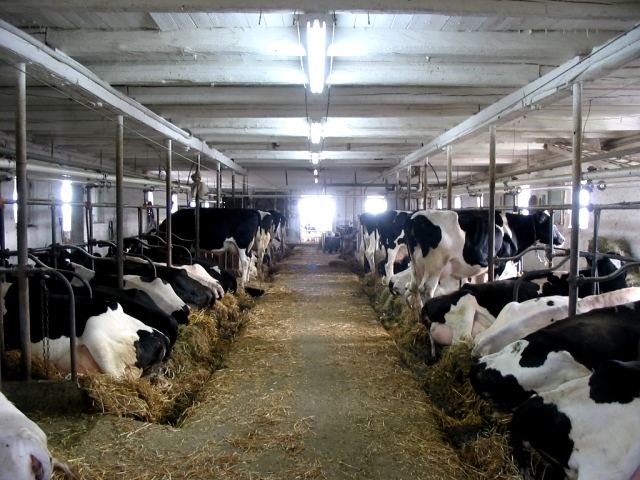 | ||
Dairy farming is one of the largest agricultural sectors in Canada. Dairy has a significant presence in all of the provinces and is one of the top two agricultural commodities in seven out of ten provinces.
Contents
In 2016, there were 959,600 dairy cows on 11,683 farms across the country. Quebec and Ontario are the major dairy producing provinces with 49% and 33% of the farms, respectively. The Canadian dairy sector contributes roughly $18.9B yearly to Canada's GDP, and sustains approximately 215,000 full-time equivalent jobs.
In Canada, dairy farming is subject to the system of supply management. Under supply management, which also includes the egg and poultry sectors, farmers manage their production so that it coincides with forecasts of demand for their products over a predetermined period - while taking into account certain imports that enter Canada, as well as some production which is shipped to export markets. Imports of dairy, eggs, and poultry are controlled using tariff rate quotas, or TRQs. These allow a predetermined quantity to be imported at preferential tariff rates (generally duty free), while maintaining control over how much is imported. The over-quota tariffs are set at levels that allow Canadian farmers to receive a price reflecting the cost to produce in a northern environment.
Supply management
The government of Canada put in place a supply management system in the early 1970s in an effort to reduce the surplus in production that had become common in the 1950s and 1960s, and ensure a fair return for farmers.
In 1970, the National Milk Marketing Plan came into effect to control supply, with the federal government and the governments of Ontario and Quebec, the two largest provinces, signing on. By 1974 every province except Newfoundland had signed on. Following dairy, a national supply management system was implemented for eggs in 1972, turkey in 1974, chicken in 1978 and chicken hatching eggs in 1986.
The basic idea behind supply management is simple, and is similar to what producers in every industry do. The goal is to manage production so that supply is in balance with demand, and that the farm gate price enables farmers to cover their costs production, including a fair return on labour and capital.
Each farm owns a number of shares in the market (quota), and is required to increase or decrease production according to consumer demand. Because production is in sync with demand, overproduction is avoided; this enables farmers to earn a predictable and stable revenue, directly from the market.
Supply management is a shared jurisdiction between the Federal and Provincial governments. For example, on a Canada-wide basis, there is the Canadian Dairy Commission, composed mostly of dairy farmers. In Ontario, there is the Dairy Farmers of Ontario, with similar local boards in each of the other provinces.
Producer Pricing
To ensure price stability for farmers, the price received by supply managed farmers takes into account both the costs of production, including capital and labour costs, and the overall conditions of the Canadian economy.
Production Discipline
To make sure that supply equals the demand from consumers, each supply managed farm in Canada owns quota (market share) that allows it to produce a certain amount. Depending on consumer demand, the amount that a quota allows you to produce can increase or decrease; upward and downward quota adjustments are made on an as-required basis. This is an efficient way to avoid overproduction, and to ensure a fair and stable return for farmers.
Import Control
In Canada, imports are controlled using tariff rate quotas, or TRQs. They allow a predetermined quantity of supply managed products to be imported at preferential tariff rates (generally duty free), while maintaining control over how much is imported. The over-quota tariffs are set at levels that allow Canadian farmers to receive a price reflecting the cost to produce in a northern environment.
History
The Canadian Dairy Farmers’ Federation was founded in 1934. The group became Dairy Farmers of Canada in 1942, and its mandate was to stabilize the dairy market and increase revenues for dairy farmers. In the face of lobbying, government programs were instituted in the 1940s and 1950s to increase prices and limit imports. 1958 saw the creation of the Agricultural Stabilization Board, though it was not limited to dairy. In the 1950s and 1960s there was significant volatility in dairy prices, dairy producers had too much bargaining power relative to dairy farmers, the United Kingdom was poised to enter the European Common Market, resulting in the loss of Canada's largest dairy export partner. These challenges led to the creation of the Canadian Dairy Commission, whose mandate was to ensure producers received a "fair" return on investment, and to ensure the quality and supply of milk, (though without concern for consumer prices).
In 1970, the National Milk Marketing Plan came into effect to control supply, with the federal government and the governments of Ontario and Quebec, the two largest provinces, signing on. By 1974 every province except Newfoundland had signed on. Concurrently with the domestic controls on supply and price, the high tariffs on imported products were put in place to protect Canadian producers from competition, and keep foreign imports to very low levels.
